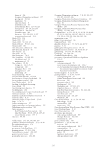9 – Caring for our sacred waterways – learning from our past 105 Invasive species are an ongoing problem. Recently, red claw crayfish (Cherax quadricarinatus) invaded the Georgina River (see Chapter 3), muddying the waters and proliferating after the 2009 floods. We run an Indigenous ranger program, involving rangers who tackle weeds and feral animals throughout the Lake Eyre Basin. The impact of livestock on our waterholes also represents a continuing problem. Feral pigs and cattle can degrade vegetation and the banks of waterholes and pollute them with their waste. By working with local pastoralists, we have had some success in restricting access by cattle to the river beds near Camooweal. Our underground rivers Few people in the Lake Eyre Basin or the rest of Australia know of the amazing underground rivers in the Georgina River catchment, including Nowranie Creek. Camooweal Caves National Park (Wiliyan-ngurru) has an extensive network of caves (Fig. 9.2), connected by sinkholes, formed when water over millennia has dissolved the dolomite deposited by ancient seas ~550 million years ago. Our stories tell us the caves were created by a giant ridge-tailed goanna (Varanus acanthurus) that used to live there – the ancestor of the resident monitor lizards. The caves fill with water during the wet season, creating one of the bigger underground river systems in the world, stretching for 36 km and 150 m deep. There are ~180 sinkholes, from Alpurrurulam (Lake Nash) in the south, right up to where the Gregory and Georgina Rivers meet in the north. Special animals have adapted to this cave life. For Fig. 9.2. The underwater tunnels inside Great Nowranie Cave, in the Camooweal Caves National Park, in the Georgina River catchment, a sacred place for Traditional Owners, where sustainability is vulnerable following revocation of Wild Rivers legislation in Queensland (photo, Liz Rogers).
Downloaded from CSIRO with access from at 216.73.216.187 on Nov 17, 2025, 1:38 PM. (c) CSIRO Publishing

















































































































































































































































































